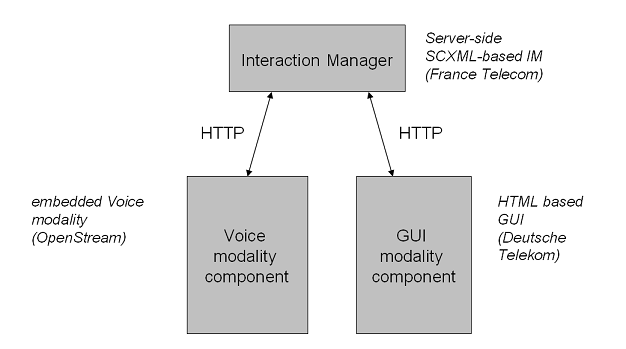3. Components of the multimodal system
Interaction Manager
The Interaction Manager is an HTTP server that runs SCXML applications and processes MMI life-cycle events. The server manages multiple SCXML interpreter instances simultaneously (one per each application context). Life-cycle events are transported via HTTP as described in Appendix E of the Multimodal Architecture and Interfaces specification. The server is Java-based and uses Commons-SCXML to interpret SCXML. HTTP transport and internal event routing is handled by Mule ESB.
An additional instanceId parameter has been added to initial HTTP requests sent by distributed Modality Components to enable instance (context) sharing. The instanceId parameter needs to be configured on each Modality Component that wants to share a context with another Modality Component. If the IM receives a NewContextRequest message with an attached instanceId that matches a previously received value, it will reuse the previously generated context ID in the NewContextResponse message. If no match is found for the provided instanceId or if the parameter is missing, the IM will generate a new context (state machine instance).
Graphical modality component
The graphical modality component has been implemented using HTML [HTML401], ECMAScript [ECMA-262] and XMLHttpRequests [XMLHTTPREQUEST].
The graphical modality component acts as a wrapper around the application specific HTML (see below) and handles
DOM events (such as click or focus) generated by the application specific HTML. The graphical modality component uses
XMLHttpRequests [XMLHTTPREQUEST] to send these events (wrapped in MMI lifecycle events) to the server side interaction manager.
Lifecycle events are received from the interaction manager also usint XMLHttpRequests (see also "Authoring Applications for the Multimodal Architecture"
[MMI-AUTH] for a more detailed description).
The following table describes the functionality and the API of the graphical modality component (see also [MMI-MCBP] for more details):
| Life Cycle Event |
Component Implementation |
| NewContextRequest |
(Standard) The component requests a new context from the IM.
Example:
<mmi:mmi xmlns:mmi="http://www.w3.org/2008/04/mmi-arch" version="1.0">
<mmi:NewContextRequest source="GUI" requestID="r1" target="MathQuiz" context="-1" />
</mmi:mmi>
|
| NewContextResponse |
(Standard) The component starts a new context and assigns the new context id to it. |
| PrepareRequest |
The component does not take any action on a PrepareRequest. |
| PrepareResponse |
The component does not send a PrepareResponse. |
| StartRequest |
The component starts processing of the document referenced by contentURL
Example:
<mmi:mmi xmlns:mmi="http://www.w3.org/2008/04/mmi-arch" version="1.0">
<mmi:StartRequest source="MathQuiz" requestID="r2" target="GUI" context="c1">
<mmi:contentURL mmi:href=”http://localhost/gui.html”/>
</mmi:StartRequest>
</mmi:mmi>
|
| StartResponse |
(Standard) |
| DoneNotification |
Not used by the modality component. |
| CancelRequest |
This component cannot cancel. |
| CancelResponse |
The component does not send a CancelResponse. |
| PauseRequest |
This component cannot pause. |
| PauseResponse |
The component does not send a PauseResponse. |
| ResumeRequest |
This component cannot resume. |
| ResumeResponse |
The component does not send a ResumeResponse. |
| ExtensionNotification (focus) |
The component sends an “ExtensionNotification” lifecycle event to the IM when an input field gets focus. The attribute “id” contains the elements ID within the HTML document.
Example:
<mmi:mmi xmlns:mmi="http://www.w3.org/2008/04/mmi-arch" version="1.0">
<mmi:ExtensionNotification mmi:name="focus" mmi:source="GUI" mmi:requestID="r2" mmi:context="c1">
<mmi:data>
<emma:emma xmlns:emma="http://www.w3.org/2003/04/emma" version="1.0">
<emma:interpretation id="int-01" emma:medium="tactile" emma:mode="ink">
<focus id="field1" value="123" />
</emma:interpretation>
</emma:emma>
</mmi:data>
</mmi:ExtensionNotification>
</mmi:mmi>
|
| ExtensionNotification (click) |
The component sends an “ExtensionNotification” lifecycle event to the IM when a button was clicked. The attribute “id” contains the buttons ID within the HTML document.
Example:
<mmi:mmi xmlns:mmi="http://www.w3.org/2008/04/mmi-arch" version="1.0">
<mmi:ExtensionNotification mmi:name="click" mmi:source="GUI" mmi:requestID="r2" mmi:context="c1">
<mmi:data>
<emma:emma xmlns:emma="http://www.w3.org/2003/04/emma" version="1.0">
<emma:interpretation id="int-01" emma:medium="tactile" emma:mode="ink">
<click id="button1" value="" />
</emma:interpretation>
</emma:emma>
</mmi:data>
</mmi:ExtensionNotification>
</mmi:mmi>
|
| ExtensionNotification (change) |
The component sends an “ExtensionNotification” lifecycle event to the IM when the content of an input field was changed.
This event will not be sent until the input field loses focus. The attribute “id” contains the input fields ID within the HTML document.
Example:
<mmi:mmi xmlns:mmi="http://www.w3.org/2008/04/mmi-arch" version="1.0">
<mmi:ExtensionNotification mmi:name="change" mmi:source="GUI" mmi:requestID="r2" mmi:context="c1">
<mmi:data>
<emma:emma xmlns:emma="http://www.w3.org/2003/04/emma" version="1.0">
<emma:interpretation id="int-01" emma:medium="tactile" emma:mode="ink">
<change id="field1" value="16" />
</emma:interpretation>
</emma:emma>
</mmi:data>
</mmi:ExtensionNotification>
</mmi:mmi>
|
| ExtensionNotification (setValue) |
The IM can send an “ExtensionNotification” lifecycle event to the modality component to set a value of an input field. The attribute “id” must contain ID of the HTML element.
Example:
<mmi:mmi version="1.0" xmlns:mmi="http://www.w3.org/2008/04/mmi-arch">
<mmi:ExtensionNotification mmi:name="setValue" mmi:target="GUI" mmi:requestID="r3" mmi:context="c1">
<mmi:data>
<function name="setValue" id="field1" value="20" />
</mmi:data>
</mmi:ExtensionNotification>
</mmi:mmi>
|
| ExtensionNotification (setFocus) |
The IM can send an “ExtensionNotification” lifecycle event to the modality component to set the focus of an input field. The attribute “id” must contain ID of the HTML element.
Example:
<mmi:mmi version="1.0" xmlns:mmi="http://www.w3.org/2008/04/mmi-arch">
<mmi:ExtensionNotification mmi:name="setValue" mmi:target="GUI" mmi:requestID="r3" mmi:context="c1">
<mmi:data>
<function name="setFocus" id="field1" value="20" />
</mmi:data>
</mmi:ExtensionNotification>
</mmi:mmi>
|
| ClearContextRequest |
(Standard) |
| clearContextResponse |
(Standard) |
| StatusRequest |
The component does not take any action on a StatusRequest. |
| StatusResponse |
The component does not take any action on a StatusRequest. |
Voice modality component
The Openstream Voice modality component(VoiceMC) is a fully conformant MMI Modality Component providing both speech-recognition (ASR) and text-to-speech (TTS) functions. It is available on various mobile and desktop platforms including iOS, Android, Blackberry, Windows Phone, Windows XP and Windows 7. Both embedded as well as MRCP v1 and v2 compliant remote speech engines are supported.
The iOS implementation of the VoiceMC running on an iPhone device running iOS 4 was used for the interoperability test. The iOS instance of the VoiceMC has been implemented in Objective-C and it uses embedded ASR and TTS engines for speech-recognition and text-to-speech.
VoiceMC communicates with an Interaction Manager(IM) using the standard MMI [MMI-ARCH] lifecycle events. HTTP is used as the transport protocol, with the component acting as a client and always initiating the connection request to the IM acting as the HTTP server. Lifecycle events that are initiated by the component are sent to the IM using HTTP POST requests. HTTP GET requests are used to receive responses from the Interaction Manager, as well as to receive new lifecycle events initiated by the IM.
On startup, the VoiceMC sends the NewContextRequest MMI lifecycle event to establish a context with the IM. Once the context is established, IM can add/remove speech recognition grammars and initiate ASR/TTS operations using the standard MMI lifecycle events. Speech recognition grammars can be added or removed using the ExtensionNotification lifecycle event. Speech-recognition and text-to-speech operations can be initiated by sending the StartRequest lifecycle event. Speech recognition result is formatted as an EMMA document and sent to the IM in the DoneNotification lifecycle event.
The following table describes the functionality and the API of the voice modality component (see also [MMI-MCBP] for more details):
| Life Cycle Event |
Component Implementation |
| NewContextRequest |
(Standard) The component requests a new context from the IM.
Example:
<mmi:mmi xmlns:mmi="http://www.w3.org/2008/04/mmi-arch" version="1.0">
<mmi:NewContextRequest source="Voice" requestID="vui-req-1" target="MathQuiz" context="-1">
</mmi:NewContextRequest>
</mmi:mmi>
|
| NewContextResponse |
(Standard) The component starts a new context and assigns the new context ID to it. |
| PrepareRequest |
The component requires a PrepareRequest event to initiate a session with a remote Voice server.
Example:
<mmi:mmi xmlns:mmi="http://www.w3.org/2008/04/mmi-arch" version="1.0">
<mmi:PrepareRequest requestID="im-req-2" target="Voice" context="MathQuiz-2be0bbb7">
<mmi:contentURL href="http://example.com/VUI/VUIProxy" max-age="" fetchtimeout="1s"/>
</mmi:PrepareRequest>
</mmi:mmi>
|
| PrepareResponse |
(Standard) The component establishes a remote Voice server session. |
| StartRequest |
The component will start an ASR or TTS operation.
Start TTS example:
<mmi:mmi version="1.0" xmlns:mmi="http://www.w3.org/2008/04/mmi-arch">
<mmi:StartRequest target="Voice" requestID="im-req-03" context="MathQuiz-2be0bbb7">
<mmi:content>play</mmi:content>
<mmi:data>You are correct. Please press next for the next question.</mmi:data>
</mmi:StartRequest>
</mmi:mmi>
Start ASR example:
<mmi:mmi version="1.0" xmlns:mmi="http://www.w3.org/2008/04/mmi-arch">
<mmi:StartRequest target="Voice" requestID="im-req-04" context="MathQuiz-2be0bbb7">
<mmi:content>recognize</mmi:content>
</mmi:StartRequest>
</mmi:mmi>
|
| StartResponse |
(Standard) |
| DoneNotification |
The Modality component returns the result of processing the ASR or TTS request. The result of matching an active grammar with a user utterance will be contained within an EMMA document.
TTS Example:
<mmi:mmi xmlns:mmi="http://www.w3.org/2008/04/mmi-arch" version="1.0">
<mmi:DoneNotification source="Voice" context="MathQuiz-2be0bbb7" status="success" requestID="vui-req-3">
</mmi:DoneNotification>
</mmi:mmi>
ASR Example:
<mmi:mmi xmlns:mmi="http://www.w3.org/2008/04/mmi-arch" version="1.0"
xmlns:emma="http://www.w3.org/2003/04/emma">
<mmi:DoneNotification source="Voice" context="MathQuiz-2be0bbb7" status="success" requestID="vui-req-4" confidential="true">
<mmi:data>
<emma:emma version="1.0">
<emma:interpretation id="int1" emma:medium="acoustic" emma:confidence=".75"
emma:mode="voice">
<answer>18</answer>
</emma:interpretation>
</emma:emma>
</mmi:data>
</mmi:DoneNotification>
</mmi:mmi>
|
| CancelRequest |
This component cannot cancel. |
| CancelResponse |
StatusInfo field is "cannot cancel". |
| PauseRequest |
This component cannot pause. |
| PauseResponse |
StatusInfo field is "cannot pause". |
| ResumeRequest |
This component cannot resume. |
| ResumeResponse |
StatusInfo field is "cannot resume". |
| ExtensionNotification |
This component processes “ExtensionNotification” lifecycle events from the IM when instructed to perform one of the following tasks:
- Add grammar with provided URL
- Remove grammar with provided URL
Add grammar example:
<mmi:mmi xmlns:mmi="http://www.w3.org/2008/04/mmi-arch" version="1.0">
<mmi:ExtensionNotification name="addGrammar" requestID="im-req-10" target="Voice" context="MathQuiz-2be0bbb7">
<mmi:data>
<grammar href=“http://example.com/app/gram/ex.gram" />
</mmi:data>
</mmi:ExtensionNotification>
</mmi:mmi>
Remove grammar example:
<mmi:mmi xmlns:mmi="http://www.w3.org/2008/04/mmi-arch" version="1.0">
<mmi:ExtensionNotification name="removeGrammar" requestID="im-req-11" target="Voice" context="MathQuiz-2be0bbb7">
<mmi:data>
<grammar href=“http://example.com/app/gram/ex.gram"/>
</mmi:data>
</mmi:ExtensionNotification>
</mmi:mmi>
This component sends the following “ExtensionNotification” lifecycle events to the IM:
- Add grammar result
- Remove grammar result
- Recording started
- Recording ended
Add grammar result example:
<mmi:mmi xmlns:mmi="http://www.w3.org/2008/04/mmi-arch" version="1.0">
<mmi:ExtensionNotification name="addGrammarResult" requestID="vui-req-12" source="Voice" context="MathQuiz-2be0bbb7">
<mmi:data>
<grammar href="http://example.com/app/gram/ex.gram" status="success"/>
</mmi:data>
</mmi:ExtensionNotification>
</mmi:mmi>
Remove grammar result example:
<mmi:mmi xmlns:mmi="http://www.w3.org/2008/04/mmi-arch" version="1.0">
<mmi:ExtensionNotification name="removeGrammarResult" requestID="vui-req-13" source="Voice" context="MathQuiz-2be0bbb7">
<mmi:data>
<grammar href="http://example.com/app/gram/ex.gram" status="success"/>
</mmi:data>
</mmi:ExtensionNotification>
</mmi:mmi>
Recording started example:
<mmi:mmi xmlns:mmi="http://www.w3.org/2008/04/mmi-arch" version="1.0">
<mmi:ExtensionNotification name="recordStarted" requestID="vui-req-14" source="Voice" context="MathQuiz-2be0bbb7">
</mmi:ExtensionNotification>
</mmi:mmi>
Recording ended example:
<mmi:mmi xmlns:mmi="http://www.w3.org/2008/04/mmi-arch" version="1.0">
<mmi:ExtensionNotification name="recordEnded" requestID="vui-req-15" source="Voice" context="MathQuiz-2be0bbb7">
</mmi:ExtensionNotification>
</mmi:mmi>
|
| ClearContextRequest |
(Standard) |
| clearContextResponse |
(Standard) |
| StatusRequest |
(Standard) |
| StatusResponse |
The component returns a standard life cycle response. The "automaticUpdate" attribute is "false", because this component does not supply automatic updates. |
4. A MathQuiz
The application
For the purpose of showing interoperability a simple math-quiz application has been
developed: the quiz consists of a series of questions given one by one until the player
chooses to stop. The question is going to be presented by voice and visual output. The
user has the opportunity to answer the quiz question either by voice or by GUI input.
Correct solutions are given immediately after the player's answers.
After starting the application a screen is presented at the GUI containing the following elements:
- a “question label” containing the question (e.g. “2+2”)
- an input element giving the user the ability to enter the solution
- an “OK” Button to confirm the input
- a “voice input activation” button for voice input acitivation (push to activate)
- a “validity label” indicating the validity of the users solution (this label might
be gray at the beginning and will be switched to red or green depending on the validity
of the users response)
- a “stop button” to stop finish application
- a “next button” to go to the next question (the “next button” is disabled by default
and will be enabled only once the user answered the question correctly)
At the same time (while starting the GUI component) the VUI component plays a prompt
with the question “what is two plus two?”.
If the user uses GUI input to answer the question he has to give input into the input
element and click the OK button. The system responds by:
- changing the “validity label” either to red or green
- enabling the “next button” in case of a right answer
- playing a prompt, either “this is correct” or “this is not correct, please try again”
If the user wants to use voice input to answer the question he has to press the microphone
button on the GUI to activate the speech recognition and speak into the microphone.
The system responds by:
- displaying the recognition result at the GUI
- changing the “validity label” either to red or green
- enabling the “next button” in case of a right answer
- playing a prompt, either “this is correct” or “this is not correct, please try again”
Life cycle event flow
The following section describes the detailed event flow during application execution and shows the details of each lifecycle event.
Figure 1 shows the initialization sequence. The dotted rectangle on the left hand side shows visual representation of the graphical
modality component. During the initialization the graphical component has not loaded any visual content.
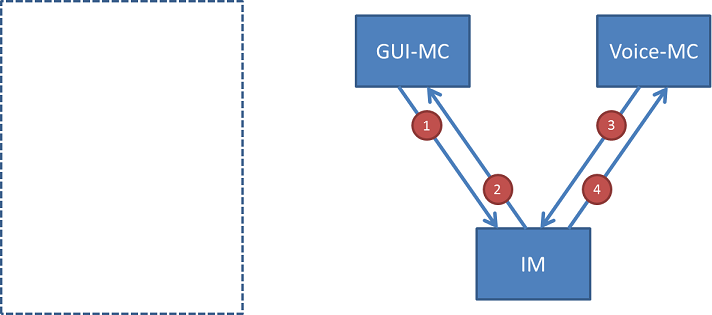
Lifecycle Event 1:
<mmi:mmi version="1.0" xmlns:mmi="http://www.w3.org/2008/04/mmi-arch">
<mmi:newContextRequest source="GUI" target="MathQuiz" requestID="gui-req-01" context="-1" />
</mmi:mmi>
Lifecycle Event 2:
<mmi:mmi version="1.0" xmlns:mmi="http://www.w3.org/2008/04/mmi-arch">
<mmi:newContextResponse target="GUI" requestID="gui-req-01" context="ctx-01" status="success" />
</mmi:mmi>
Lifecycle Event 3:
<mmi:mmi version="1.0" xmlns:mmi="http://www.w3.org/2008/04/mmi-arch">
<mmi:newContextRequest source="Voice" target="MathQuiz" requestID="voice-req-01" context="-1" />
</mmi:mmi>
Lifecycle Event 4:
<mmi:mmi version="1.0" xmlns:mmi="http://www.w3.org/2008/04/mmi-arch">
<mmi:newContextResponse target="Voice" requestID="voice-req-01" context="ctx-01" status="success" />
</mmi:mmi>
After all modality components have connected to the interaction manager, the preparation sequence is started by the interaction manager. In this configuration the voice modality component is instructed to load application specific grammars. The graphical component still has not loaded any visual content.
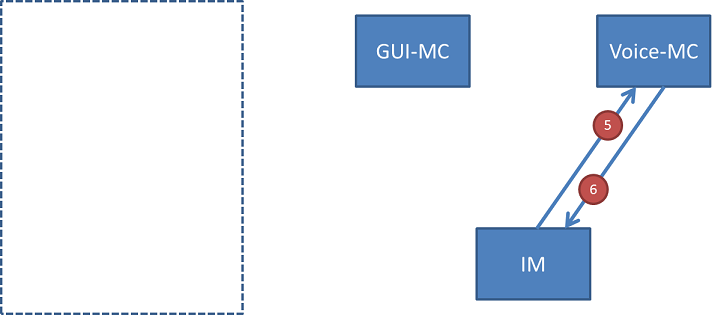
Lifecycle Event 5:
<mmi:mmi xmlns:mmi="http://www.w3.org/2008/04/mmi-arch" version="1.0">
<mmi:extensionNotification name="addGrammar" requestID="im-req-v2" target="Voice" context="ctx-01">
<mmi:data><grammar href="http://example.com/mathQuiz/gram/answer_options.gram"/></mmi:data>
</mmi:extensionNotification>
</mmi:mmi>Lifecycle Event 6:
<mmi:mmi xmlns:mmi="http://www.w3.org/2008/04/mmi-arch" version="1.0">
<mmi:extensionNotification name="addGrammarResult" requestID="im-req-v2" source="Voice" context="ctx-01">
<mmi:data><grammar href="http://example.com/mathQuiz/gram/answer_options.gram" status="success"/></mmi:data>
</mmi:extensionNotification>
</mmi:mmi>Now, as the voice modality component has been prepared, the interaction manager starts the actual application. It sends StartRequests to both
modality components. The graphical modality component loads and displays the "welcome.html" page, which is shown on the left hand side. The voice modality component plays the following prompt to the user: "Welcome to the Math-Quiz. Please press 'Start' to continue."
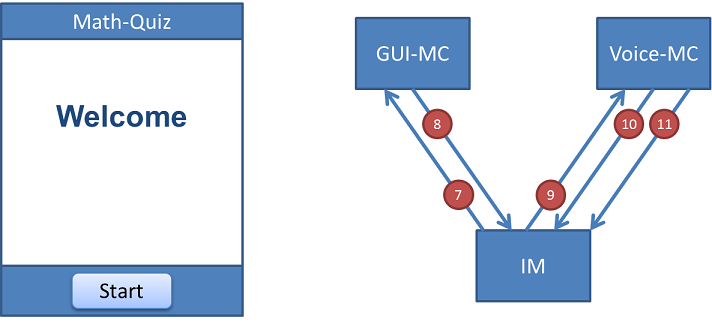
Lifecycle Event 7:
<mmi:mmi version="1.0" xmlns:mmi="http://www.w3.org/2008/04/mmi-arch">
<mmi:startRequest target="GUI" requestID="im-req-01" context="ctx-01">
<mmi:contentURL href="welcome.html" />
</mmi:startRequest>
</mmi:mmi>Lifecycle Event 8:
<mmi:mmi version="1.0" xmlns:mmi="http://www.w3.org/2008/04/mmi-arch">
<mmi:startResponse source="GUI" requestID="im-req-01" context="ctx-01" status="success" />
</mmi:mmi>
Lifecycle Event 9:
<mmi:mmi version="1.0" xmlns:mmi="http://www.w3.org/2008/04/mmi-arch">
<mmi:startRequest target="Voice" requestID="im-req-v3" context="ctx-01">
<mmi:data><voice cmd="play"><text>Welcome to the math quiz. Please press Start to continue.</text></voice></mmi:data>
</mmi:startRequest>
</mmi:mmi>Lifecycle Event 10:
<mmi:mmi version="1.0" xmlns:mmi="http://www.w3.org/2008/04/mmi-arch">
<mmi:startResponse source="Voice" requestID="im-req-v3" context="ctx-01" status="success" />
</mmi:mmi>
Lifecycle Event 11:
<mmi:mmi xmlns:mmi="http://www.w3.org/2008/04/mmi-arch" version="1.0">
<mmi:doneNotification source="Voice" context="ctx-01" status="success" requestID="im-req-v3" >
</mmi:doneNotification>
</mmi:mmi>
To start the application, the user presses the "Start" button on the graphical modality component. This leads to an ExtensionNotification
lifecycle event, which contains the click event represented within an EMMA [EMMA] document.
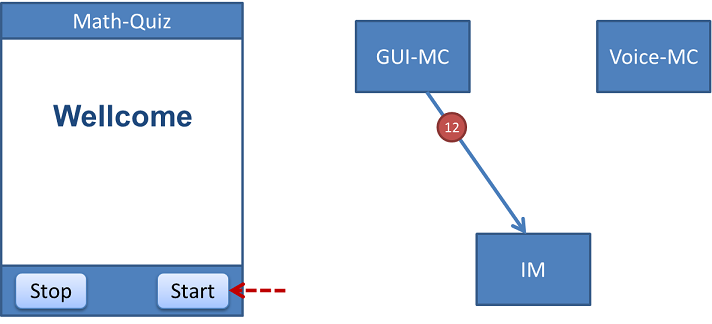
Lifecycle Event 12:
<mmi:mmi version="1.0" xmlns:mmi="http://www.w3.org/2008/04/mmi-arch">
<mmi:extensionNotification name="click" source="GUI" requestID="gui-req-02" context="ctx-01">
<mmi:data>
<emma:emma version="1.0" xmlns:emma="http://www.w3.org/2003/04/emma">
<emma:interpretation id="int-01" emma:medium="tactile" emma:mode="ink">
<click id="start_button" value="" />
</emma:interpretation>
</emma:emma>
</mmi:data>
</mmi:extensionNotification>
</mmi:mmi>The interaction manager script sends StartRequests to both modality components. The graphical modality component loads the visual representation of the first math quiz question whereas the voice modality is instructed to play the question "What is 7 plus 9?"
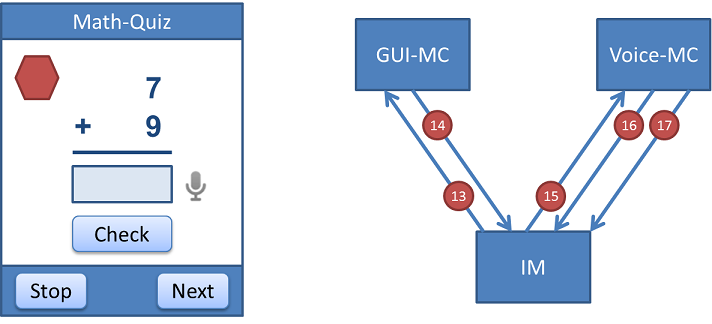
Lifecycle Event 13:
<mmi:mmi version="1.0" xmlns:mmi="http://www.w3.org/2008/04/mmi-arch">
<mmi:startRequest target="GUI" requestID="im-req-03" context="ctx-01">
<mmi:contentURL href="question1.html" />
</mmi:startRequest>
</mmi:mmi>Lifecycle Event 14:
<mmi:mmi version="1.0" xmlns:mmi="http://www.w3.org/2008/04/mmi-arch">
<mmi:startResponse source="GUI" requestID="im-req-03" context="ctx-01" status="success" />
</mmi:mmi>
Lifecycle Event 15:
<mmi:mmi version="1.0" xmlns:mmi="http://www.w3.org/2008/04/mmi-arch">
<mmi:startRequest target="Voice" requestID="im-req-v4" context="ctx-01">
<mmi:data><voice cmd="play"><text>Welcome What is 7 plus 9?</text></voice></mmi:data>
</mmi:startRequest>
</mmi:mmi>Lifecycle Event 16:
<mmi:mmi version="1.0" xmlns:mmi="http://www.w3.org/2008/04/mmi-arch">
<mmi:startResponse source="Voice" requestID="im-req-v4" context="ctx-01" status="success" />
</mmi:mmi>
Lifecycle Event 17:
<mmi:mmi xmlns:mmi="http://www.w3.org/2008/04/mmi-arch" version="1.0">
<mmi:doneNotification source="Voice" context="ctx-01" status="success" requestID="im-req-v4" >
</mmi:doneNotification>
</mmi:mmi>
The user now uses the keyboard to enter the answer (types "1" and "6"). The application dependent HTML has been written in a way that the change event is used to send the value of the input element to the interaction manager. The change event is thrown as soon as the input element looses its focus (and not when the actual input occurs, this is why there is no lifecycle event generated as a direct result to the keyboard input of "1" and "6"), which happens when the user clicks the "check" button. Thus two lifecycle events are sent to the interaction manager immediately after each other.
The user hits the "1" on the keyboard:
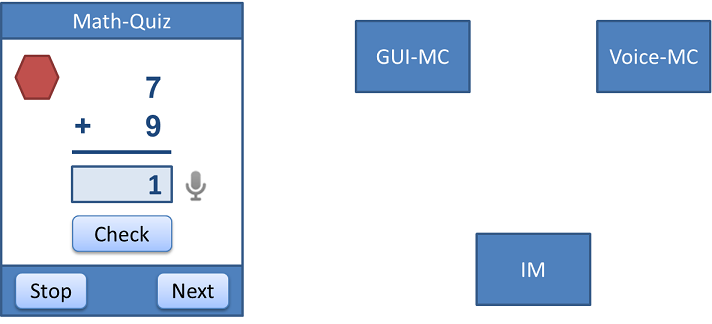
The user hits the "6" on the keyboard:
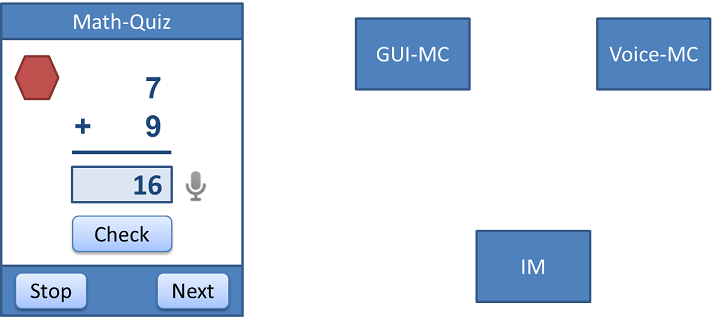
The user clicks the "check" button, which leads to the "change" and "click" HTML DOM events, which are handled by the modality components scripts and wrapped into two lifecycle events:
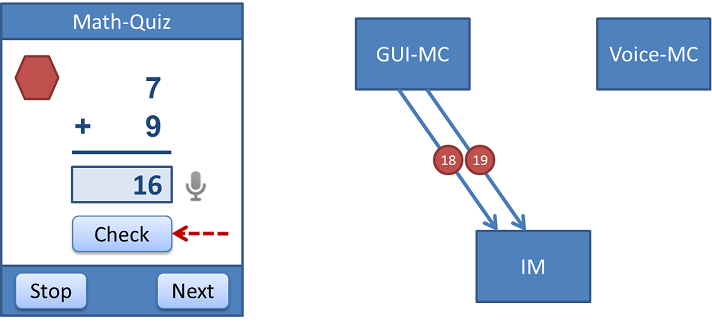
Lifecycle Event 18:
<mmi:mmi version="1.0" xmlns:mmi="http://www.w3.org/2008/04/mmi-arch">
<mmi:extensionNotification name="change" source="GUI" requestID="gui-req-03" context="ctx-01">
<mmi:data>
<emma:emma version="1.0" xmlns:emma="http://www.w3.org/2003/04/emma">
<emma:interpretation id="int-01" emma:medium="tactile" emma:mode="ink">
<change id="answer_field" value="16" />
</emma:interpretation>
</emma:emma>
</mmi:data>
</mmi:extensionNotification>
</mmi:mmi>Lifecycle Event 19:
<mmi:mmi version="1.0" xmlns:mmi="http://www.w3.org/2008/04/mmi-arch">
<mmi:extensionNotification name="click" source="GUI" requestID="gui-req-04" context="ctx-01">
<mmi:data>
<emma:emma version="1.0" xmlns:emma="http://www.w3.org/2003/04/emma">
<emma:interpretation id="int-01" emma:medium="tactile" emma:mode="ink">
<click id="check_button" value="" />
</emma:interpretation>
</emma:emma>
</mmi:data>
</mmi:extensionNotification>
</mmi:mmi>The interaction manager script (application dependent SCXML, see below) checks the users input. Since the answer is correct, it sends an ExtensionNotification lifecycle event to the graphical modality component to change the result indicator to green color. A StartRequest is used to instruct the voice modality component to play "This is correct. Please press 'Next' for another question or press 'Stop' to finish the application."
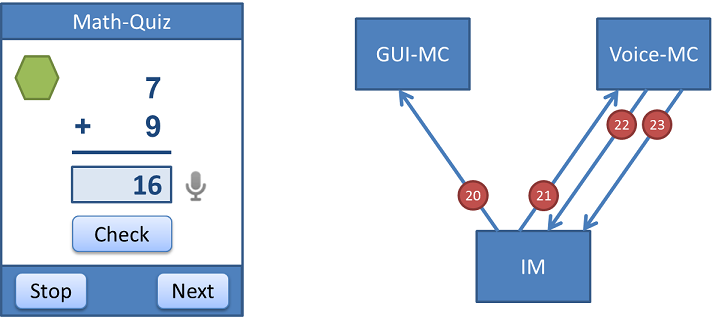
Lifecycle Event 19:
<mmi:mmi version="1.0" xmlns:mmi="http://www.w3.org/2008/04/mmi-arch">
<mmi:extensionNotification name="click" source="GUI" requestID="gui-req-04" context="ctx-01">
<mmi:data>
<emma:emma version="1.0" xmlns:emma="http://www.w3.org/2003/04/emma">
<emma:interpretation id="int-01" emma:medium="tactile" emma:mode="ink">
<click id="check_button" value="" />
</emma:interpretation>
</emma:emma>
</mmi:data>
</mmi:extensionNotification>
</mmi:mmi>Lifecycle Event 20:
<mmi:mmi version="1.0" xmlns:mmi="http://www.w3.org/2008/04/mmi-arch">
<mmi:extensionNotification name="setValue" target="GUI" requestID="im-req-05" context="ctx-01">
<mmi:data>
<function name="setValue" id="result_identifier" value="on" />
</mmi:data>
</mmi:startRequest>
</mmi:mmi>Lifecycle Event 21:
<mmi:mmi version="1.0" xmlns:mmi="http://www.w3.org/2008/04/mmi-arch">
<mmi:startRequest target="Voice" requestID="im-req-v5" context="ctx-01">
<mmi:data><voice cmd="play"><text>This is correct. Please press Next for another question or press Stop to finish the application.</text></voice></mmi:data>
</mmi:startRequest>
</mmi:mmi>Lifecycle Event 22:
<mmi:mmi version="1.0" xmlns:mmi="http://www.w3.org/2008/04/mmi-arch">
<mmi:startResponse source="Voice" requestID="im-req-v5" context="ctx-01" status="success" />
</mmi:mmi>
Lifecycle Event 23:
<mmi:mmi xmlns:mmi="http://www.w3.org/2008/04/mmi-arch" version="1.0">
<mmi:doneNotification source="Voice" context="ctx-01" status="success" requestID="im-req-v5" >
</mmi:doneNotification>
</mmi:mmi>
Since the user clicks "Next", the graphical modality component again sends an ExtensionNotification lifecycle event to the interaction manager.
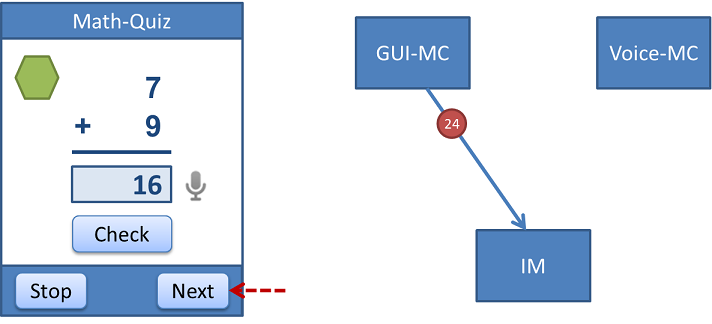
Lifecycle Event 24:
<mmi:mmi version="1.0" xmlns:mmi="http://www.w3.org/2008/04/mmi-arch">
<mmi:extensionNotification name="click" source="GUI" requestID="gui-req-05" context="ctx-01">
<mmi:data>
<emma:emma version="1.0" xmlns:emma="http://www.w3.org/2003/04/emma">
<emma:interpretation id="int-01" emma:medium="tactile" emma:mode="ink">
<click id="next_button" value="" />
</emma:interpretation>
</emma:emma>
</mmi:data>
</mmi:extensionNotification>
</mmi:mmi>As above, the interaction manager script instructs both modality components to load new markup and play a prompt to present the next math quiz question to the user.
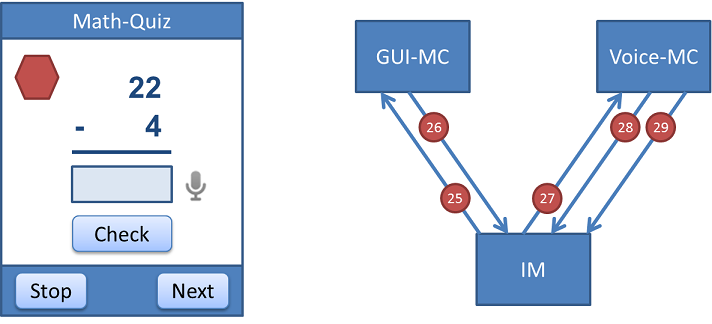
Lifecycle Event 25:
<mmi:mmi version="1.0" xmlns:mmi="http://www.w3.org/2008/04/mmi-arch">
<mmi:startRequest target="GUI" requestID="im-req-07" context="ctx-01">
<mmi:contentURL href="question2.html" />
</mmi:startRequest>
</mmi:mmi>Lifecycle Event 26:
<mmi:mmi version="1.0" xmlns:mmi="http://www.w3.org/2008/04/mmi-arch">
<mmi:startResponse source="GUI" requestID="im-req-07" context="ctx-01" status="success" />
</mmi:mmi>
Lifecycle Event 27:
<mmi:mmi version="1.0" xmlns:mmi="http://www.w3.org/2008/04/mmi-arch">
<mmi:startRequest target="Voice" requestID="im-req-v6" context="ctx-01">
<mmi:data><voice cmd="play"><text>What is 22 minus 4?</text></voice></mmi:data>
</mmi:startRequest>
</mmi:mmi>Lifecycle Event 28:
<mmi:mmi version="1.0" xmlns:mmi="http://www.w3.org/2008/04/mmi-arch">
<mmi:startResponse source="Voice" requestID="im-req-v6" context="ctx-01" status="success" />
</mmi:mmi>
Lifecycle Event 29:
<mmi:mmi xmlns:mmi="http://www.w3.org/2008/04/mmi-arch" version="1.0">
<mmi:doneNotification source="Voice" context="ctx-01" status="success" requestID="im-req-v6" >
</mmi:doneNotification>
</mmi:mmi>
This time the user decides to use the voice modality to answer the question. To activate the speech recognition he clicks the microphone button at the GUI. Again, a generic lifecycle event is sent to the interaction manager, representing the click at the microphone HTML element. The interaction manager script sends a StartRequest lifecycle event to the voice modality to instruct it to open the microphone and start the speech recognition process.
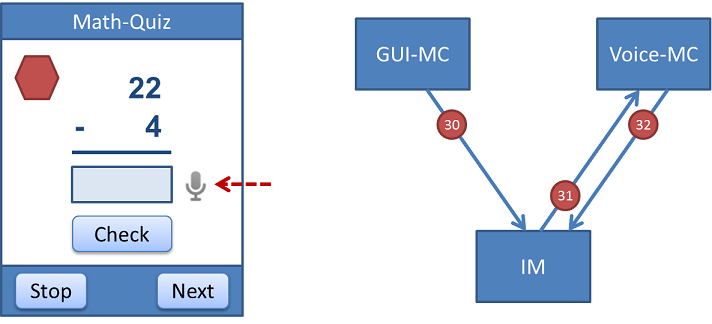
Lifecycle Event 30:
<mmi:mmi version="1.0" xmlns:mmi="http://www.w3.org/2008/04/mmi-arch">
<mmi:extensionNotification name="click" source="GUI" requestID="gui-req-06" context="ctx-01">
<mmi:data>
<emma:emma version="1.0" xmlns:emma="http://www.w3.org/2003/04/emma">
<emma:interpretation id="int-01" emma:medium="tactile" emma:mode="ink">
<click id="voice_input_activation_button" value="" />
</emma:interpretation>
</emma:emma>
</mmi:data>
</mmi:extensionNotification>
</mmi:mmi>Lifecycle Event 31:
<mmi:mmi version="1.0" xmlns:mmi="http://www.w3.org/2008/04/mmi-arch">
<mmi:startRequest target="Voice" requestID="im-req-v7" context="ctx-01">
<mmi:data><voice cmd="recognize"/></mmi:data>
</mmi:startRequest>
</mmi:mmi>Lifecycle Event 32:
<mmi:mmi version="1.0" xmlns:mmi="http://www.w3.org/2008/04/mmi-arch">
<mmi:startResponse source="Voice" requestID="im-req-v7" context="ctx-01" status="success" />
</mmi:mmi>
The user speaks "twenty" into the microphone. After automatic endpointing the voice modality component uses a DoneNotification lifecycle event to send the users input to the interaction manager. Note that this information is represented using an EMMA document.
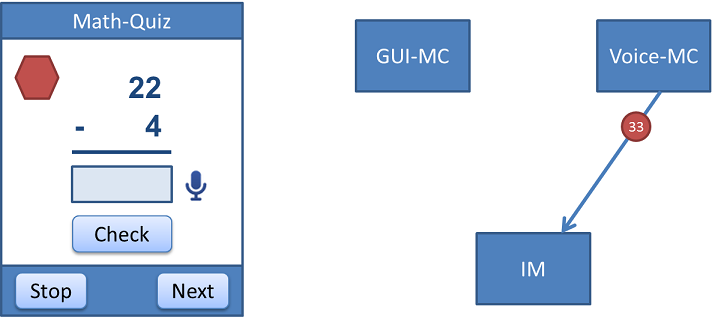
Lifecycle Event 33:
<mmi:mmi xmlns:mmi="http://www.w3.org/2008/04/mmi-arch" version="1.0">
<mmi:doneNotification source="Voice" context="ctx-01" status="success" requestID="im-req-v7" >
<mmi:data>
<emma:emma version="1.0" xmlns:emma="http://www.w3.org/2003/04/emma">
<emma:interpretation id="int1" emma:medium="acoustic" emma:confidence=".75" emma:mode="voice">
<answer>20</answer>
</emma:interpretation>
</emma:emma>
</mmi:data>
</mmi:doneNotification>
</mmi:mmi>To display the result of the voice input at the GUI the interaction manager script sends an extensionNotification lifecycle event to instruct the graphical modality component to change the value of the HTML input field accordingly.
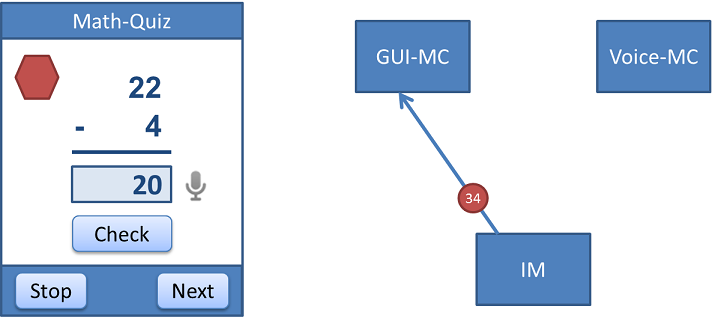
Lifecycle Event 34:
<mmi:mmi version="1.0" xmlns:mmi="http://www.w3.org/2008/04/mmi-arch">
<mmi:extensionNotification name="setValue" target="GUI" requestID="im-req-10" context="ctx-01">
<mmi:data>
<function name="setValue" id="answer_field" value="20" />
</mmi:data>
</mmi:extensionNotification>
</mmi:mmi>Again the user clicks the "Check" button at the GUI to check the input for correctness.
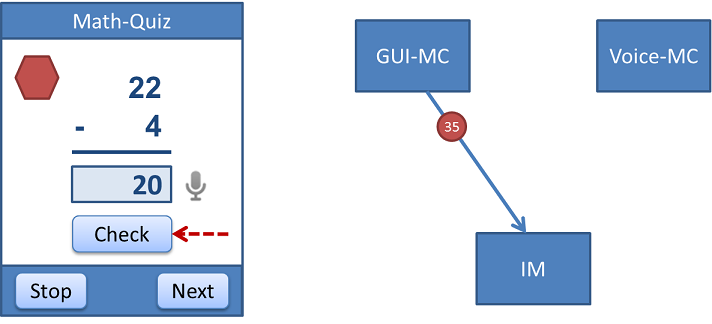
Lifecycle Event 35:
<mmi:mmi version="1.0" xmlns:mmi="http://www.w3.org/2008/04/mmi-arch">
<mmi:extensionNotification name="click" source="GUI" requestID="gui-req-07" context="ctx-01">
<mmi:data>
<emma:emma version="1.0" xmlns:emma="http://www.w3.org/2003/04/emma">
<emma:interpretation id="int-01" emma:medium="tactile" emma:mode="ink">
<click id="check_button" value="" />
</emma:interpretation>
</emma:emma>
</mmi:data>
</mmi:extensionNotification>
</mmi:mmi>Since this answer is not correct, the interaction manager instructs the voice modality component to play "This is not correct. Please try again." Note that the voice modality component sends two lifecycle events in response to the StartRequest. A StartResponse immediately after it has started to play out the prompt and a DoneNotification once it has finished the prompt.
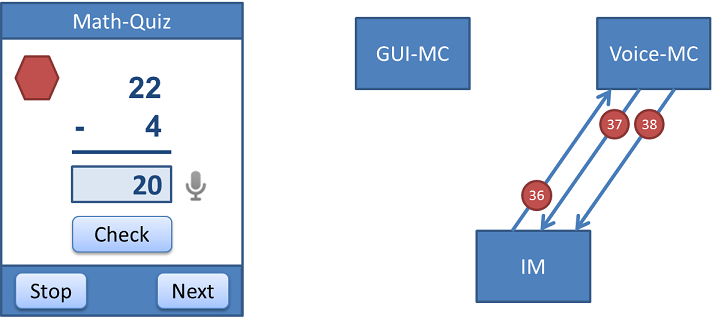
Lifecycle Event 36:
<mmi:mmi version="1.0" xmlns:mmi="http://www.w3.org/2008/04/mmi-arch">
<mmi:startRequest target="Voice" requestID="im-req-v8" context="ctx-01">
<mmi:data><voice cmd="play"><text>This is not correct. Please try again.</text></voice></mmi:data>
</mmi:startRequest>
</mmi:mmi>Lifecycle Event 37:
<mmi:mmi version="1.0" xmlns:mmi="http://www.w3.org/2008/04/mmi-arch">
<mmi:startResponse source="Voice" requestID="im-req-v8" context="ctx-01" status="success" />
</mmi:mmi>
Lifecycle Event 38:
<mmi:mmi xmlns:mmi="http://www.w3.org/2008/04/mmi-arch" version="1.0">
<mmi:doneNotification source="Voice" context="ctx-01" status="success" requestID="im-req-v8" >
</mmi:doneNotification>
</mmi:mmi>
Again the user tries to answer the questions, this time using the keyboard. He types "1" and "8" on his keyboard.
The user hits the "1" on the keyboard:
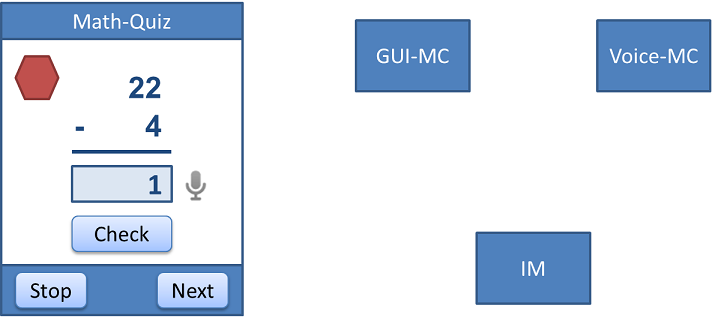
The user hits the "8" on the keyboard:
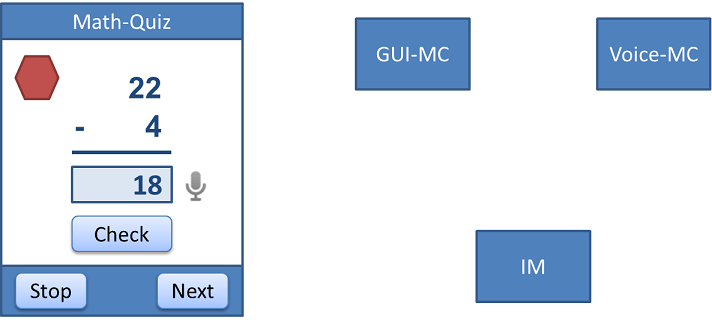
The user clicks the "check" button, which leads to the "change" and "click" HTML DOM events, which are handled by the modality components scripts and wrapped into two lifecycle events:
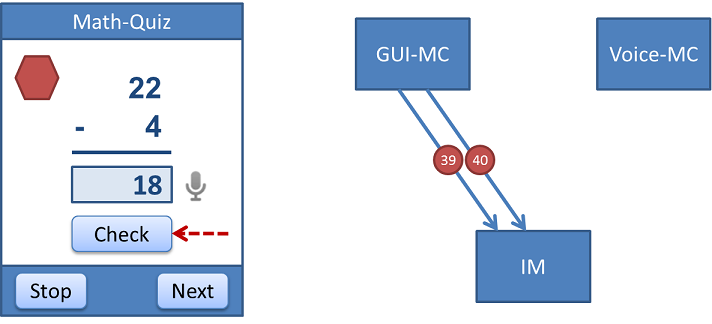
Again, since this is a generic behavior of the graphical modality component, two lifecycle events are sent to the interaction manager immediately after each other.
Lifecycle Event 39:
<mmi:mmi version="1.0" xmlns:mmi="http://www.w3.org/2008/04/mmi-arch">
<mmi:extensionNotification name="change" source="GUI" requestID="gui-req-08" context="ctx-01">
<mmi:data>
<emma:emma version="1.0" xmlns:emma="http://www.w3.org/2003/04/emma">
<emma:interpretation id="int-01" emma:medium="tactile" emma:mode="ink">
<change id="answer_field" value="18" />
</emma:interpretation>
</emma:emma>
</mmi:data>
</mmi:extensionNotification>
</mmi:mmi>Lifecycle Event 40:
<mmi:mmi version="1.0" xmlns:mmi="http://www.w3.org/2008/04/mmi-arch">
<mmi:extensionNotification name="click" source="GUI" requestID="gui-req-09" context="ctx-01">
<mmi:data>
<emma:emma version="1.0" xmlns:emma="http://www.w3.org/2003/04/emma">
<emma:interpretation id="int-01" emma:medium="tactile" emma:mode="ink">
<click id="check_button" value="" />
</emma:interpretation>
</emma:emma>
</mmi:data>
</mmi:extensionNotification>
</mmi:mmi>This input is checked within the interaction manager script and since it is correct the interaction manager will send lifecycle events both modality components to change the visual indicator to green color and to play "This is correct. Please press 'Next' for another question or press 'Stop' to finish the application."
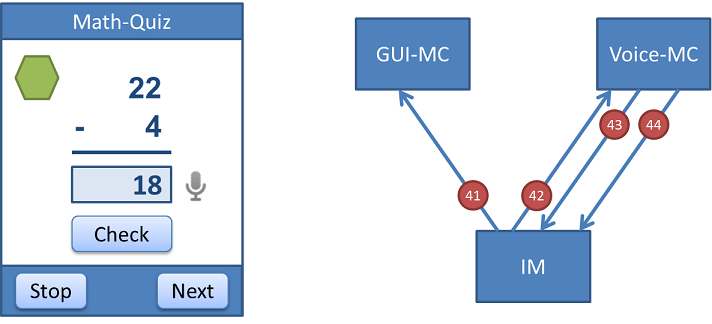
Lifecycle Event 41:
<mmi:mmi version="1.0" xmlns:mmi="http://www.w3.org/2008/04/mmi-arch">
<mmi:extensionNotification name="setValue" target="GUI" requestID="im-req-13" context="ctx-01">
<mmi:data>
<function name="setValue" id="result_identifier" value="on" />
</mmi:data>
</mmi:startRequest>
</mmi:mmi>Lifecycle Event 42:
<mmi:mmi version="1.0" xmlns:mmi="http://www.w3.org/2008/04/mmi-arch">
<mmi:startRequest target="Voice" requestID="im-req-v9" context="ctx-01">
<mmi:data><voice cmd="play"><text>This is correct. Please press Next for another question or Stop to finish the application.</text></voice></mmi:data>
</mmi:startRequest>
</mmi:mmi>Lifecycle Event 43:
<mmi:mmi version="1.0" xmlns:mmi="http://www.w3.org/2008/04/mmi-arch">
<mmi:startResponse source="Voice" requestID="im-req-v9" context="ctx-01" status="success" />
</mmi:mmi>
Lifecycle Event 44:
<mmi:mmi xmlns:mmi="http://www.w3.org/2008/04/mmi-arch" version="1.0">
<mmi:doneNotification source="Voice" context="ctx-01" status="success" requestID="im-req-v9" >
</mmi:doneNotification>
</mmi:mmi>
The user decides to stop the quiz at this point and clicks the "Stop" button at the GUI.
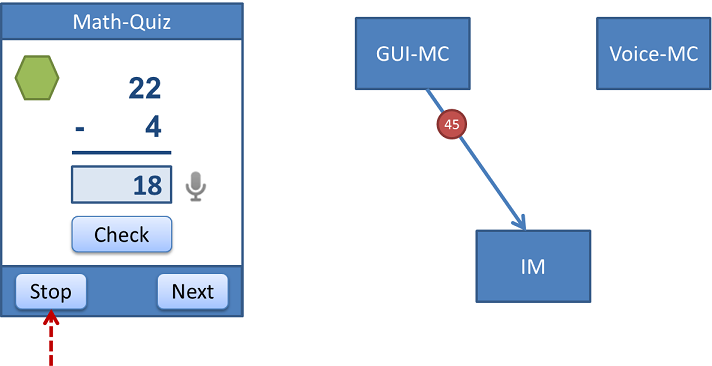
Lifecycle Event 45:
<mmi:mmi version="1.0" xmlns:mmi="http://www.w3.org/2008/04/mmi-arch">
<mmi:extensionNotification name="click" source="GUI" requestID="gui-req-10" context="ctx-01">
<mmi:data>
<emma:emma version="1.0" xmlns:emma="http://www.w3.org/2003/04/emma">
<emma:interpretation id="int-01" emma:medium="tactile" emma:mode="ink">
<click id="stop_button" value="" />
</emma:interpretation>
</emma:emma>
</mmi:data>
</mmi:extensionNotification>
</mmi:mmi>The interaction manager now sends StartRequests to both component to display a "Goodbye" page and play "Thank you and goodbye."

Lifecycle Event 46:
<mmi:mmi version="1.0" xmlns:mmi="http://www.w3.org/2008/04/mmi-arch">
<mmi:startRequest target="GUI" requestID="im-req-15" context="ctx-01">
<mmi:contentURL href="goodbye.html" />
</mmi:startRequest>
</mmi:mmi>Lifecycle Event 47:
<mmi:mmi version="1.0" xmlns:mmi="http://www.w3.org/2008/04/mmi-arch">
<mmi:startResponse source="GUI" requestID="im-req-15" context="ctx-01" status="success" />
</mmi:mmi>
Lifecycle Event 48:
<mmi:mmi version="1.0" xmlns:mmi="http://www.w3.org/2008/04/mmi-arch">
<mmi:startRequest target="Voice" requestID="im-req-v10" context="ctx-01">
<mmi:data><voice cmd="play"><text>Thank you and goodbye.</text></voice></mmi:data>
</mmi:startRequest>
</mmi:mmi>Lifecycle Event 49:
<mmi:mmi version="1.0" xmlns:mmi="http://www.w3.org/2008/04/mmi-arch">
<mmi:startResponse source="Voice" requestID="im-req-v10" context="ctx-01" status="success" />
</mmi:mmi>
Lifecycle Event 50:
<mmi:mmi xmlns:mmi="http://www.w3.org/2008/04/mmi-arch" version="1.0">
<mmi:doneNotification source="Voice" context="ctx-01" status="success" requestID="im-req-v10" >
</mmi:doneNotification>
</mmi:mmi>
A. Application scripts
The application consists of two components which use markup languages. The interaction
manager uses the state chart description language SCXML [SCXML] to build the
application specific functionality, whereas the GUI modality component uses HTML
[HTML401] for the application specific part.
SCXML
The following figure shows a visual representation of the interaction manager state machine.
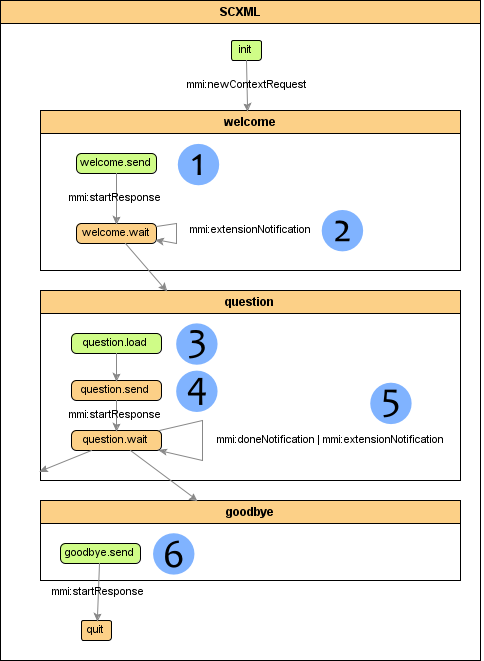
- Send 'welcome' StartRequests to both Modality Components. Provide HTML page URL in the GUI-MC StartRequest, and text to synthesize in the Voice-MC StartRequest.
- Process ExtensionNotification events from Modality Components. At this stage, we collect and register GUI events. Once a condition has been satisfied (a "clicked" event occurred on the "start_button" object), proceed to the next state.
- Load a question. In a more complex setup, this could mean fetching data from a question database; here, we simply switch between two hardcoded question/answer pairs.
- Send 'question' StartRequests to both Modality Components.
- Process ExtensionNotification/DoneNotification events from Modality Components. Once a condition has been satisfied, perform an appropriate action:
- if the GUI "voice input activation button" has been clicked, send a "recognize" command to the Voice MC
- if an answer has been provided by either of the Modality Components, evaluate the answer and send the result to both MCs
- if the GUI "next" button has been clicked, transition to next question
- if the GUI "stop" button has been clicked, transition to the "goodbye" state
- Send 'goodbye' StartRequests to both Modality Components.
The following markup code shows the SCXML which describes the application logic.
The code is loaded by the interaction manager at application start.
<?xml version="1.0" encoding="UTF-8"?>
<scxml xmlns="http://www.w3.org/2005/07/scxml"
xmlns:commons="http://commons.apache.org/scxml"
xmlns:emma="http://www.w3.org/2003/04/emma"
xmlns:xsi="http://www.w3.org/2001/XMLSchema-instance"
xmlns:mmi="http://www.w3.org/2008/04/mmi-arch"
xsi:schemaLocation="http://www.w3.org/2005/07/scxml scxml.xsd http://commons.apache.org/scxml commons.xsd http://www.w3.org/2008/04/mmi-arch mmi.xsd http://www.w3.org/2003/04/emma emma.xsd" version="1.0"
initialstate="init">
<!-- data model definition -->
<datamodel>
<!-- top-level variables -->
<data name="contextId" />
<data name="requestId" />
<data name="sourceMC" />
<data name="source" expr="IM" />
<data name="gui_events">
<clicked xmlns="" />
<changed xmlns="" />
<value xmlns="" />
</data>
<data name="ttsWelcome">
<voice xmlns="" cmd="play"><text><![CDATA[Welcome to the math quiz. Please press start to continue.]]></text></voice>
</data>
<data name="ttsQuestion">
<voice xmlns="" cmd="play"><text><![CDATA[Question placeholder.]]></text></voice>
</data>
<data name="ttsCorrect">
<voice xmlns="" cmd="play"><text><![CDATA[This is correct. Please press Next for another question or press Stop to finish the application.]]></text></voice>
</data>
<data name="ttsIncorrect">
<voice xmlns="" cmd="play"><text><![CDATA[This is not correct. Please try again.]]></text></voice>
</data>
<data name="ttsGoodbye">
<voice xmlns="" cmd="play"><text><![CDATA[Thank you and goodbye.]]></text></voice>
</data>
<data name="cmdRecognize">
<voice xmlns="" cmd="recognize"></voice>
</data>
<data name="initGrammar">
<grammar xmlns="" href="http://64.9.100.106/mmi/mathQuiz/gram/answer_options.gram"/>
</data>
<data name="url" />
<data name="problem">
<text xmlns="" />
<answer xmlns="" />
<id xmlns="" />
<url xmlns="" />
</data>
<data name="setCorrect">
<function xmlns="" name="setValue" id="result_identifier" value="on" />
</data>
<data name="setIncorrect">
<function xmlns="" name="setValue" id="result_identifier" value="off" />
</data>
<data name="setAnswer">
<function xmlns="" name="setValue" id="answer_field" value="" />
</data>
</datamodel>
<state id="init">
<onentry>
<log label="[init]" expr="Waiting for new context request..." />
</onentry>
<transition event="mmi:newContextRequest" target="welcome">
<assign name="requestId" expr="${Data(_eventdata, '//mmi:newContextRequest/@requestID')}" />
<assign name="sourceMC" expr="${Data(_eventdata, '//mmi:newContextRequest/@source')}" />
<assign name="contextId" expr="${mmi:newContextId()}" />
<commons:var name="newContextResponse" expr="${mmi:newContextResponse(contextId, source, sourceMC, requestId)}" />
<send event="mmi:newContextResponse" target="${sourceMC}" targettype="MC" namelist="newContextResponse" />
</transition>
</state>
<state id="welcome">
<onentry>
<assign location="${Data(problem, 'id')}" expr="1" />
<commons:var name="extensionNotification" expr="${mmi:newExtensionNotification(contextId, source, 'Voice', mmi:newRequestId(contextId), 'addGrammar', initGrammar)}" />
<send event="mmi:extensionNotification" target="Voice" targettype="MC" namelist="extensionNotification" />
</onentry>
<initial>
<transition target="welcome.send"/>
</initial>
<state id="welcome.send">
<onentry>
<commons:var name="startRequest" expr="${mmi:newStartRequest(contextId, source, 'GUI', mmi:newRequestId(contextId), 'welcome.html', null)}" />
<send event="mmi:startRequest" target="GUI" targettype="MC" namelist="startRequest" />
<commons:var name="startRequest" expr="${mmi:newStartRequest(contextId, source, 'Voice', mmi:newRequestId(contextId), 'welcome.vxml', ttsWelcome)}" />
<send event="mmi:startRequest" target="Voice" targettype="MC" namelist="startRequest" />
</onentry>
<transition event="mmi:startResponse" target="welcome.wait" />
</state>
<state id="welcome.wait">
<transition event="mmi:extensionNotification" target="welcome.wait">
<if cond="${Data(_eventdata, '//click/@id') ne ''}">
<assign location="${Data(gui_events, 'clicked')}" expr="${Data(_eventdata, '//click/@id')}" />
</if>
</transition>
<transition cond="${Data(gui_events, 'clicked') eq 'start_button'}" target="question" />
</state>
</state>
<state id="question">
<initial>
<transition target="question.load"/>
</initial>
<state id="question.send">
<onentry>
<assign name="url" expr="${Data(problem, 'url')}" />
<commons:var name="startRequestGUI" expr="${mmi:newStartRequest(contextId, source, 'GUI', mmi:newRequestId(contextId), url, null)}" />
<send event="mmi:startRequest" target="GUI" targettype="MC" namelist="startRequestGUI" />
<assign location="${Data(ttsQuestion, 'voice/text')}" expr="${Data(problem, 'text')}" />
<commons:var name="startRequestVoice" expr="${mmi:newStartRequest(contextId, source, 'Voice', mmi:newRequestId(contextId), 'question.vxml', ttsQuestion)}" />
<send event="mmi:startRequest" target="Voice" targettype="MC" namelist="startRequestVoice" />
</onentry>
<transition event="mmi:startResponse" target="question.wait"/>
</state>
<state id="question.wait">
<transition event="mmi:extensionNotification" target="question.wait">
<if cond="${Data(_eventdata, '//click/@id') ne ''}">
<assign location="${Data(gui_events, 'clicked')}" expr="${Data(_eventdata, '//click/@id')}" />
</if>
<if cond="${Data(_eventdata, '//change/@id') ne ''}">
<assign location="${Data(gui_events, 'changed')}" expr="${Data(_eventdata, '//change/@id')}" />
<assign location="${Data(gui_events, 'value')}" expr="${Data(_eventdata, '//change/@value')}" />
</if>
</transition>
<transition event="mmi:doneNotification" target="question.wait">
<if cond="${Data(_eventdata, '//answer') ne ''}">
<assign location="${Data(gui_events, 'value')}" expr="${Data(_eventdata, '//answer')}" />
<assign location="${Data(gui_events, 'clicked')}" expr="check_button" />
<assign location="${Data(setAnswer, 'function/@value')}" expr="${Data(gui_events, 'value')}" />
<commons:var name="extensionNotification" expr="${mmi:newExtensionNotification(contextId, source, sourceMC, mmi:newRequestId(contextId), 'setValue', setAnswer)}" />
<send event="mmi:extensionNotification" target="GUI" targettype="MC" namelist="extensionNotification" />
</if>
</transition>
<transition cond="${Data(gui_events, 'clicked') eq 'voice_input_activation_button'}" target="question.wait">
<assign location="${Data(gui_events, 'clicked')}" expr="" />
<commons:var name="startRequestVoice" expr="${mmi:newStartRequest(contextId, source, 'Voice', mmi:newRequestId(contextId), 'question.vxml', cmdRecognize)}" />
<send event="mmi:startRequest" target="Voice" targettype="MC" namelist="startRequestVoice" />
</transition>
<transition cond="${Data(gui_events, 'clicked') eq 'check_button'}" target="question.wait">
<assign location="${Data(gui_events, 'clicked')}" expr="" />
<if cond="${Data(gui_events, 'value') eq Data(problem, 'answer')}">
<commons:var name="extensionNotification" expr="${mmi:newExtensionNotification(contextId, source, sourceMC, mmi:newRequestId(contextId), 'setValue', setCorrect)}" />
<send event="mmi:extensionNotification" target="GUI" targettype="MC" namelist="extensionNotification" />
<commons:var name="startRequestVoice" expr="${mmi:newStartRequest(contextId, source, 'Voice', mmi:newRequestId(contextId), 'question.vxml', ttsCorrect)}" />
<send event="mmi:startRequest" target="Voice" targettype="MC" namelist="startRequestVoice" />
<else />
<commons:var name="extensionNotification" expr="${mmi:newExtensionNotification(contextId, source, sourceMC, mmi:newRequestId(contextId), 'setValue', setIncorrect)}" />
<send event="mmi:extensionNotification" target="GUI" targettype="MC" namelist="extensionNotification" />
<commons:var name="startRequestVoice" expr="${mmi:newStartRequest(contextId, source, 'Voice', mmi:newRequestId(contextId), 'question.vxml', ttsIncorrect)}" />
<send event="mmi:startRequest" target="Voice" targettype="MC" namelist="startRequestVoice" />
<assign location="${Data(ttsQuestion, 'voice/text')}" expr="${Data(problem, 'text')}" />
<commons:var name="startRequestVoice" expr="${mmi:newStartRequest(contextId, source, 'Voice', mmi:newRequestId(contextId), 'question.vxml', ttsQuestion)}" />
<send event="mmi:startRequest" target="Voice" targettype="MC" namelist="startRequestVoice" />
<commons:var name="startRequestVoice" expr="${mmi:newStartRequest(contextId, source, 'Voice', mmi:newRequestId(contextId), 'question.vxml', cmdRecognize)}" />
<send event="mmi:startRequest" target="Voice" targettype="MC" namelist="startRequestVoice" />
</if>
</transition>
<transition cond="${Data(gui_events, 'clicked') eq 'stop_button'}" target="goodbye">
<assign location="${Data(gui_events, 'clicked')}" expr="" />
</transition>
<transition cond="${Data(gui_events, 'clicked') eq 'next_button'}" target="question">
<assign location="${Data(gui_events, 'clicked')}" expr="" />
</transition>
</state>
<state id="question.load">
<onentry>
<if cond="${(Data(problem, 'id') mod 2) eq 1}">
<assign location="${Data(problem, 'text')}" expr="What is 7 plus 9?" />
<assign location="${Data(problem, 'answer')}" expr="16" />
<assign location="${Data(problem, 'url')}" expr="question1.html" />
</if>
<if cond="${(Data(problem, 'id') mod 2) eq 0}">
<assign location="${Data(problem, 'text')}" expr="What is 22 minus 4?" />
<assign location="${Data(problem, 'answer')}" expr="18" />
<assign location="${Data(problem, 'url')}" expr="question2.html" />
</if>
<assign location="${Data(problem, 'id')}" expr="${Data(problem, 'id') + 1}" />
</onentry>
<transition target="question.send"/>
</state>
</state>
<state id="goodbye">
<initial>
<transition target="goodbye.send"/>
</initial>
<state id="goodbye.send">
<onentry>
<commons:var name="startRequest" expr="${mmi:newStartRequest(contextId, source, sourceMC, mmi:newRequestId(contextId), 'goodbye.html')}" />
<send event="mmi:startRequest" target="${sourceMC}" targettype="MC" namelist="startRequest" />
<commons:var name="startRequestVoice" expr="${mmi:newStartRequest(contextId, source, 'Voice', mmi:newRequestId(contextId), 'question.vxml', ttsGoodbye)}" />
<send event="mmi:startRequest" target="Voice" targettype="MC" namelist="startRequestVoice" />
</onentry>
<transition event="mmi:startResponse" target="quit" />
</state>
</state>
<state id="quit">
</state>
</scxml>HTML
The following HTML code shows the welcome.html page, which represents the application
specific markup and will be loaded from the graphical modality component as a reaction
to a mmi:StartRequest lifecycle event.
<!DOCTYPE html PUBLIC "-//W3C//DTD XHTML 1.0 Transitional//EN" "http://www.w3.org/TR/xhtml1/DTD/xhtml1-transitional.dtd">
<html xmlns="http://www.w3.org/1999/xhtml" xml:lang="de" lang="de">
<head>
<title>Welcome - MathQuiz</title>
<link href="css/layout.css" rel="stylesheet" type="text/css" />
<script type="text/javascript">
var EVENTTYPES = new Array();
var HTMLELEMENTS = new Array();
var FORMELEMENTS = new Array();
EVENTTYPES[0] = new Array("click");
HTMLELEMENTS[0] = new Array("input");
FORMELEMENTS[0] = new Array("button");
</script>
</head>
<body class="col3_only">
<div class="page_margins">
<div id="header">
Math-Quiz
</div>
<div id="main">
<div id="col1">
</div>
<div id="col2">
</div>
<div id="col3">
<div id="col3_content">
<p class="center">Welcome</p>
</div>
</div>
</div>
<div id="footer">
<input id="start_button" type="button" value="Start" />
</div>
</div>
</body>
</html>
The application code above contains some ECMAScript varialbes (arrays such as EVENTTYPES). These variables give
the application author control over which DOM elements are to be handled by the graphical modality component wrapper
and forwarded to the interaction manager. This functionality is used to optimize performance and to avoid flooding the
interaction manager with events like mouse movements or hover.
The following figure shows a graphical representation of the application dependent 'welcome' page:

There are similar HTML documents for other stages of the application which will be
loaded in reaction to other mmi:StartRequest lifecycle events.
Grammar
This ABNF speech grammar [SPEECH-GRAMMAR] has been used by the voice modality component to
recognize the math quiz results:
#ABNF 1.0 iso-8859-1;
language en-US;
mode voice;
root $mathquizanswer;
tag-format <semantics/1.0>;
public $mathquizanswer =
1|2|3|4|5|6|7|8|9|10|11|12|13|14|15|16|17|18|19|20;
The modality component loads this grammar in response to a ExtensionNotification lifecycle event (see description above).
Recognition results are compiled into an EMMA [EMMA] document and sent to the interaction manager using a DoneNotification
lifecycle event.
